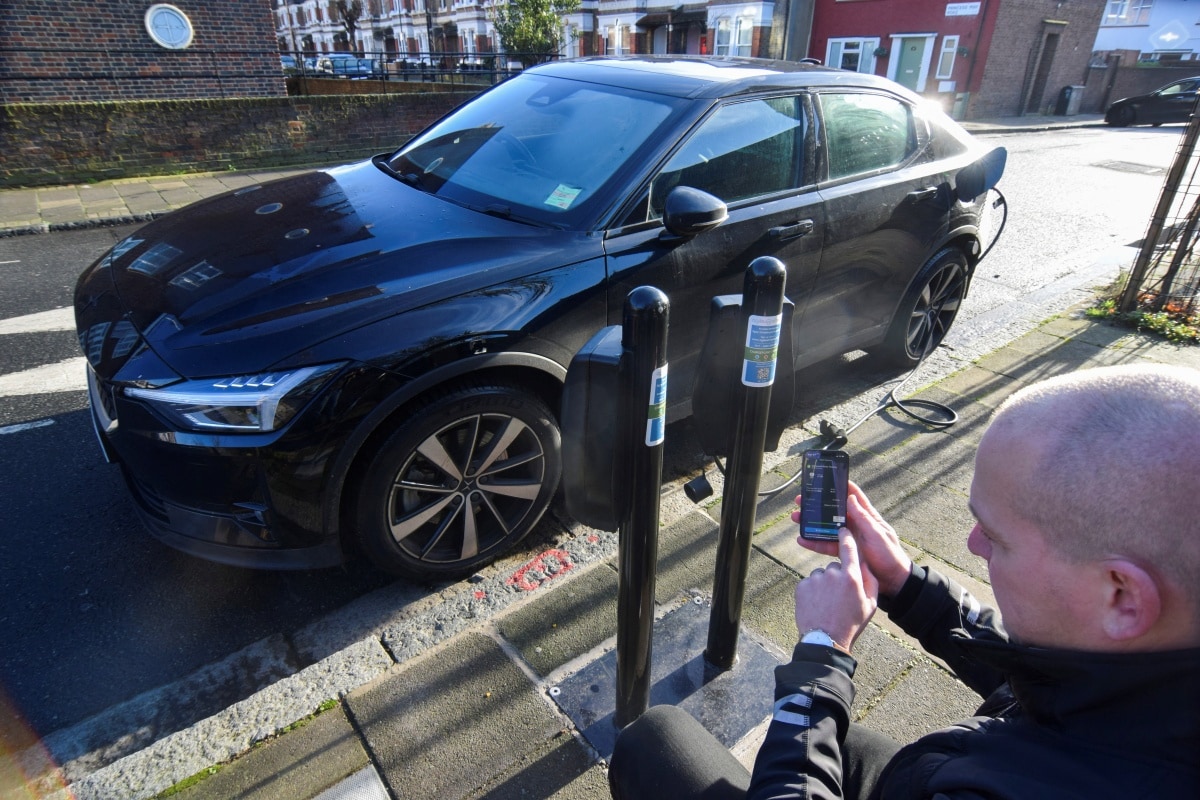As electrical car (EV) gross sales rise, the massive query for energy grid operators, charging firms, and governments is the best way to run tens of tens of millions of automobiles with out crashing native networks or spending billions on grid upgrades.
The reply: good charging.
Merely put, good charging software program permits EV homeowners to plug in throughout costly peak hours, with out the car drawing energy till low cost off-peak hours. This eases pressure on the electrical grid, makes higher use of renewable vitality and saves drivers cash.
With out it, tens of millions of EV homeowners plugging in after work – auditing agency EY estimates Europe can have 65 million EVs by 2030 and 130 million by 2035 – may overload native grids, inflicting blackouts.
“The shift to electrical will likely be nigh on inconceivable with out good charging,” Chris Pateman-Jones, CEO of British EV charger firm Related Kerb, advised Reuters whereas demonstrating a pilot mission on public chargers in Hackney, a London borough.
Utilizing Related Kerb’s smartphone app you may set your charging velocity, cost time and precise worth right down to a low, gradual “Eco” price of $0.26 (roughly Rs. 20) per kilowatt.
“It is a lot cheaper and less complicated,” stated Ged O’Sullivan, a 65-year-old pub proprietor who lower his plug-in hybrid’s charging invoice by 30 p.c with Related Kerb.
Sensible charging for public chargers is a big problem as a result of so few can be found for individuals who can’t cost at dwelling as a result of they park on the road.
In response to a report from EY and Eurelectric, Europe alone will want 9 million public chargers by 2035, up from 374,000 at present.
The close to future must also carry “bidirectional” or “vehicle-to-grid” charging, the place tens of millions of EV homeowners may promote their EV batteries’ juice again to grid operators throughout peak hours.
Even in Britain the place good charging at house is extensively out there, many EV homeowners are unaware it exists, in line with Britain’s vitality regulator, Ofgem. In the USA, solely a tiny fraction of utilities provide it, in line with utilities group the Sensible Electrical Energy Alliance.
And few vehicles at present beside Renault and Hyundai’s upcoming Ioniq mannequin are able to bidirectional charging – although extra are coming.
“Most vehicles, at this level, don’t assist this bidirectional charging but,” stated Robin Berg, CEO of We Drive Photo voltaic, which has equipped lots of of bidirectional chargers for a pilot mission within the central Dutch metropolis of Utrecht and labored with Renault SA and Hyundai Motor Co on their automobiles. “Different carmakers will observe.”
Practically 20 p.c of recent vehicles offered within the Netherlands and virtually 12 p.c in Britain in 2021 have been absolutely electrical.
State assist has put Norway on the forefront of electrification, the place EVs made up virtually three-quarters of gross sales within the capital Oslo. Some native substations have been constructed within the Fifties and with out good charging Oslo would wish large, expensive grid upgrades.
“To deal with this we’d like good charging options as a result of we do not wish to over-invest within the grid,” stated Sture Portvik, who heads Oslo’s charging infrastructure efforts.
‘Consciousness is low’
Related Kerb goals to have 190,000 UK on-street chargers by 2030, enabling it to foretell shopper charging patterns for grid operators and provide decrease charges when the out there renewable vitality is plentiful, stated Pateman-Jones.
“Immediately when there’s an excessive amount of wind on the grid, wind farms are advised to show the wind generators off,” he stated. “With good charging we will pull extra of that energy.”
Some UK vitality suppliers already provide low off-peak charges for dwelling good charging, however few EV homeowners use them.
“The notion is wise charging at house is a completed deal,” stated Charlie Cook dinner, CEO of Rightcharge, a UK agency that helps EV homeowners discover low tariffs. “However the actuality is consciousness of those tariffs is surprisingly low.”
Rightcharge estimates good charging may save UK drivers GBP 10 billion (roughly Rs. 1,02,180 crore) by 2030.
British automobile supplier community Lookers guides EV patrons to Rightcharge’s web site to test their choices.
Lookers’ enterprise improvement director, Andrew Corridor, stated “early adopter” EV patrons are “fairly savvy about good charging.”
“However that’s altering as EV gross sales rise,” he added.
Utilities group the Sensible Electrical Energy Alliance estimates solely 50 out of three,000 US utilities provide good charging.
EV charging firm ChargePoint’s US chargers can all smart-charge, nevertheless it needs extra utilities to supply it.
“We see a number of constructive response from clients when their utility is providing these charges,” stated Anthony Harrison, ChargePoint’s North American head of utility partnerships.
Charging supplier Blink Charging Co has one set price till good charging is extensively out there.
“We determined to maintain it easy for our clients,” stated Blink CEO Michael Farkas.
‘Horrendously costly’
Bidirectional charging could also be essential.
“The entire concept behind bidirectional charging is to steadiness the grid,” stated We Drive Photo voltaic’s Berg, who estimates a totally charged EV can energy the typical dwelling within the Netherlands for every week.
Serge Colle, EY’s international vitality sources chief, stated good and bidirectional charging are higher than “horrendously costly” energy grid upgrades.
“We will not probably open up streets shortly sufficient so as to add extra copper and do the mandatory reinforcement,” Colle stated.
Regulator Ofgem estimates that peak energy reductions from good and bidirectional charging by 2050 may match “10 Hinkley Level C Nuclear Crops” – a two-reactor plant beneath development in England.
The US market has greater than 10 vehicle-to-grid pilot initiatives utilizing college buses beneath method.
California-based vehicle-to-grid firm Nuvve Holding has shaped Levo, a three way partnership with personal fairness agency Stonepeak – which chipped in $750 million (roughly Rs. 5,660 crore) – to allow EV fleet homeowners to promote energy to utilities.
“As a result of our clients are in a position to generate income we’re in a position to scale back the entire value of possession for these automobiles, at occasions fully cost-neutral,” stated Nuvve CEO Gregory Poilasne.
Charger makers like Brisbane, Australia-based Tritium Dcfc are additionally creating bidirectional chargers.
CEO Jane Hunter stated Tritium will launch a bidirectional, fast-charging wall unit in 2023 for fleets and householders.
Extra automakers are embracing bidirectional charging. Ford has partnered with solar energy firm Sunrun Inc to make use of its F-150 Lightning pickup truck to energy properties.
However Oslo has invested extra cash in pilot initiatives for bidirectional chargers as a result of it believes within the idea. Up to now, nonetheless, it has been disenchanted that extra carmakers haven’t but launched automobiles that may feed energy again into the grid.
“The constraints for bidirectional charging has been the automobile producers,” infrastructure chief Portvik stated. “The massive carmakers should step up.”
© Thomson Reuters 2022












